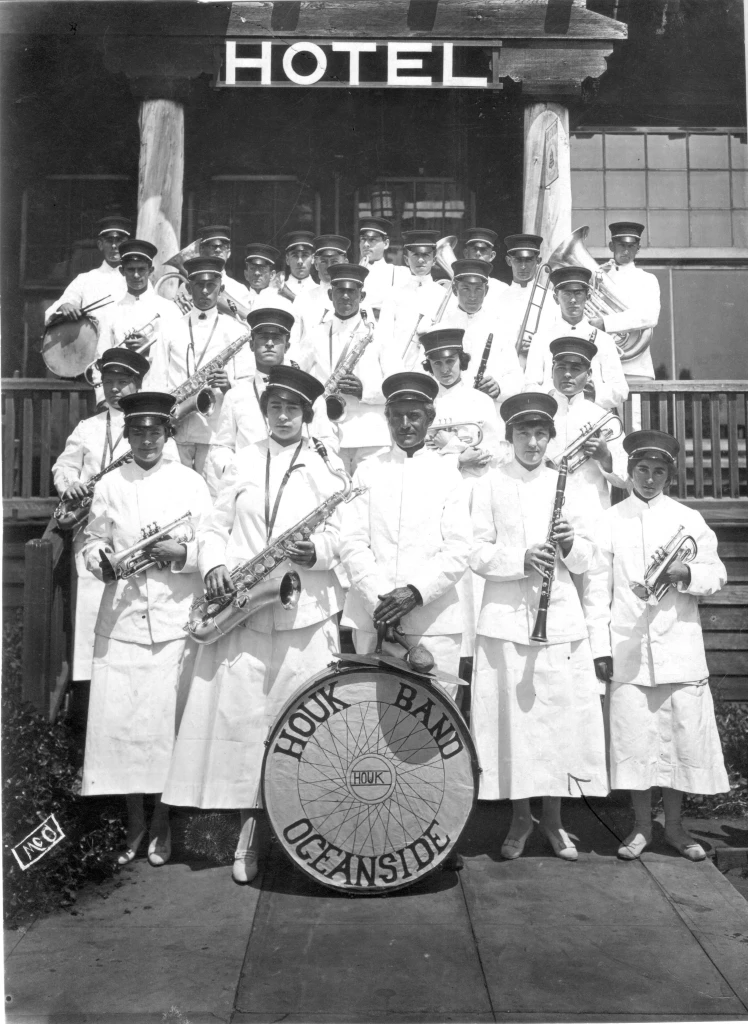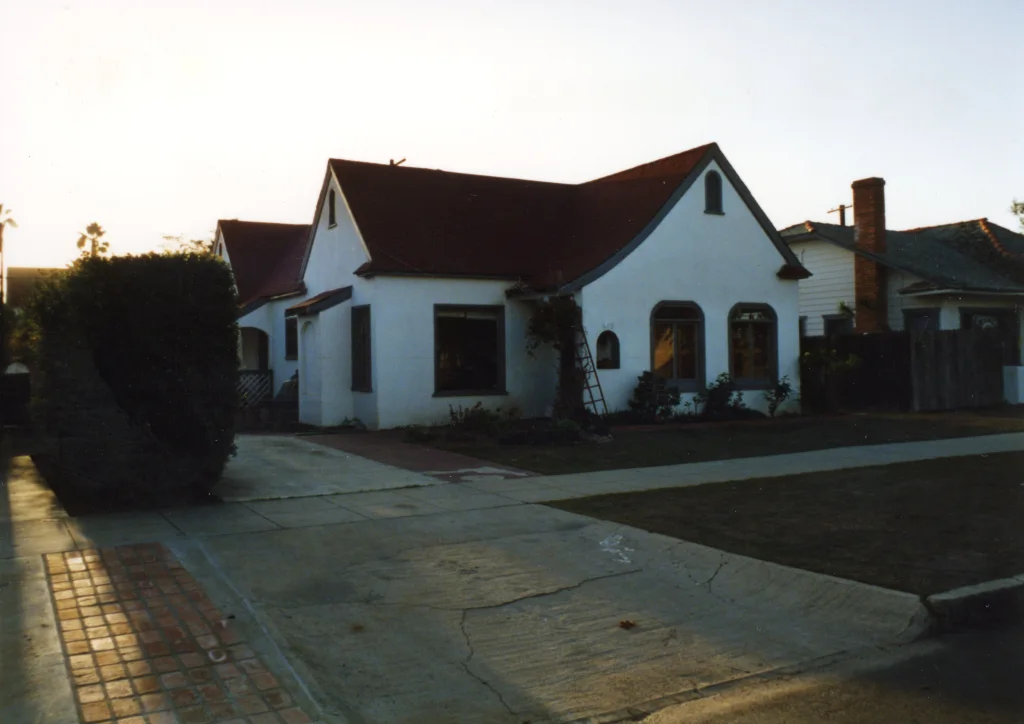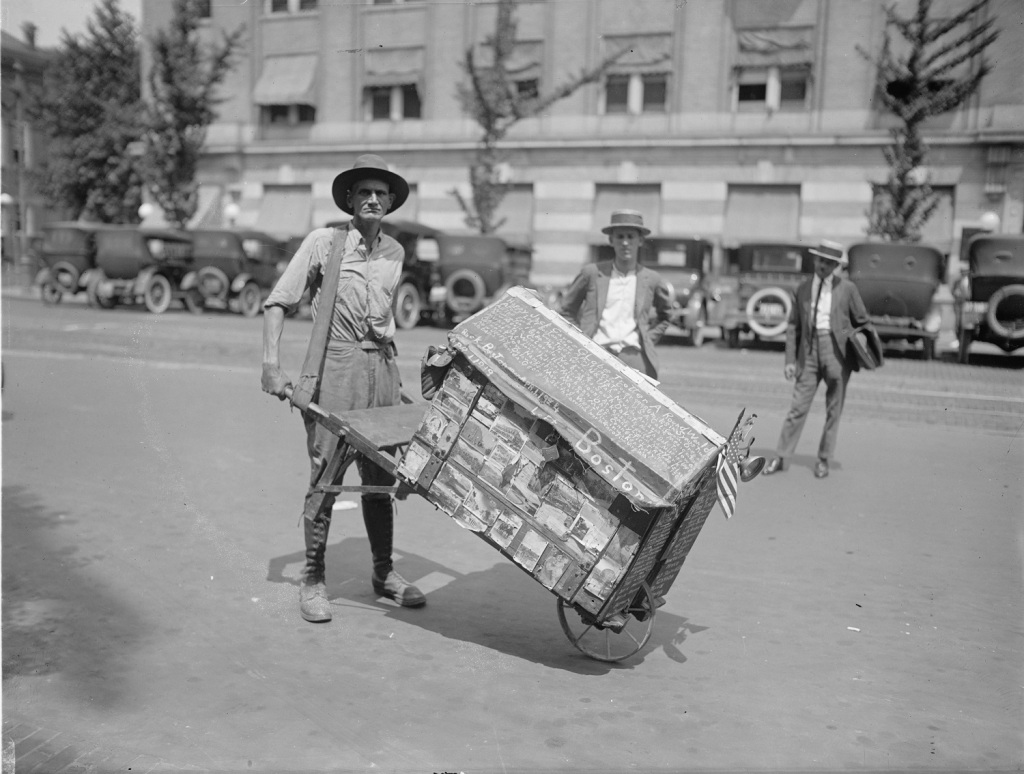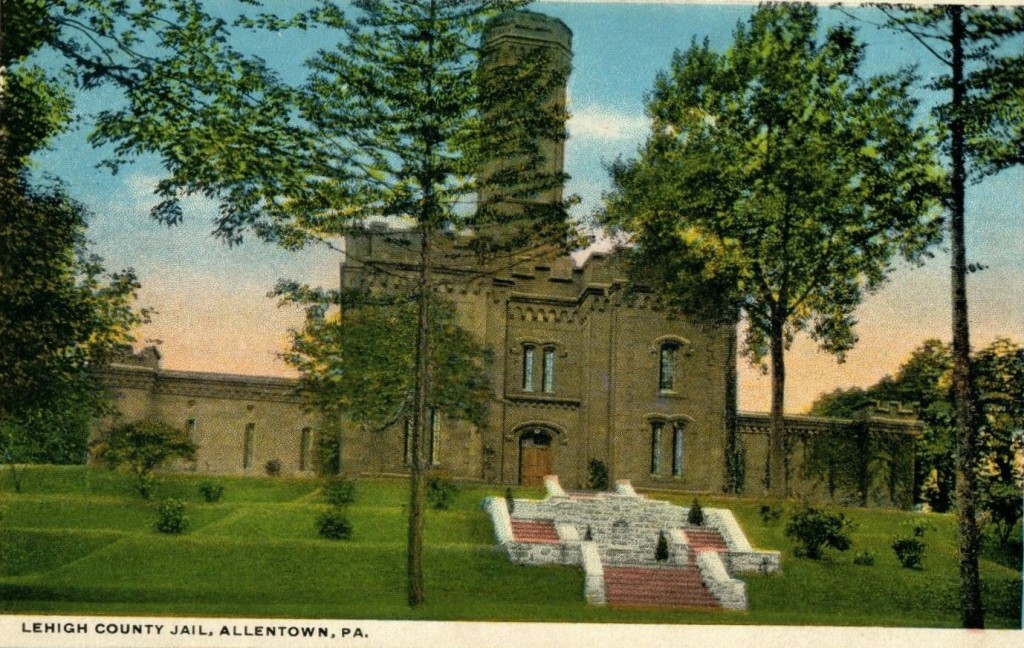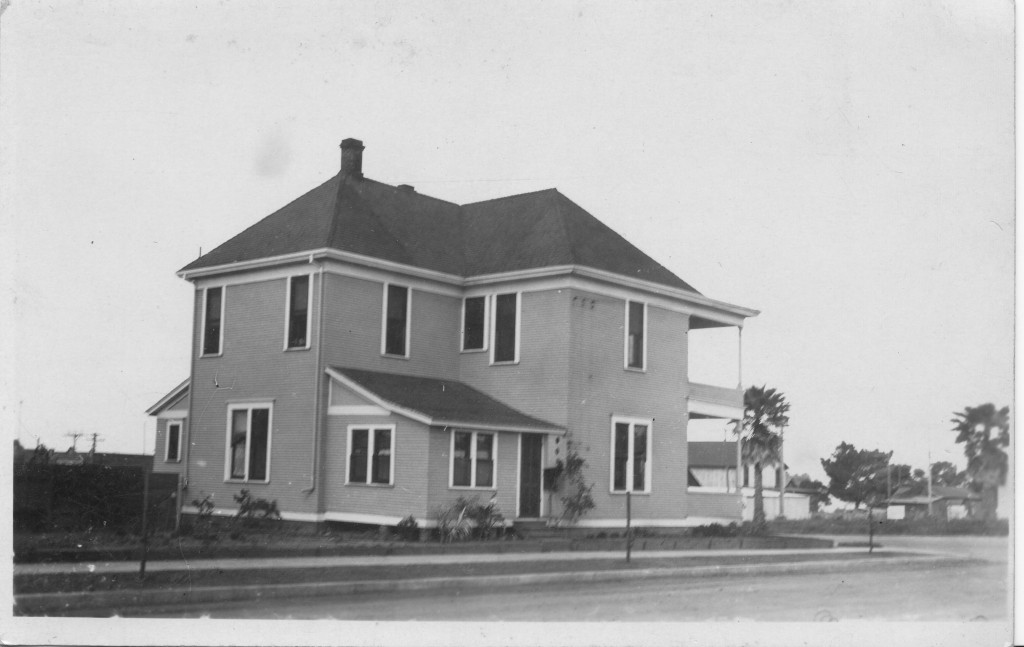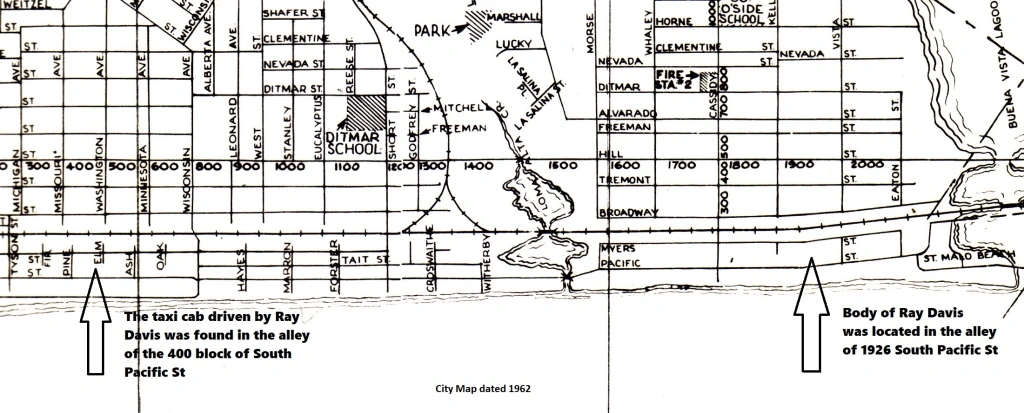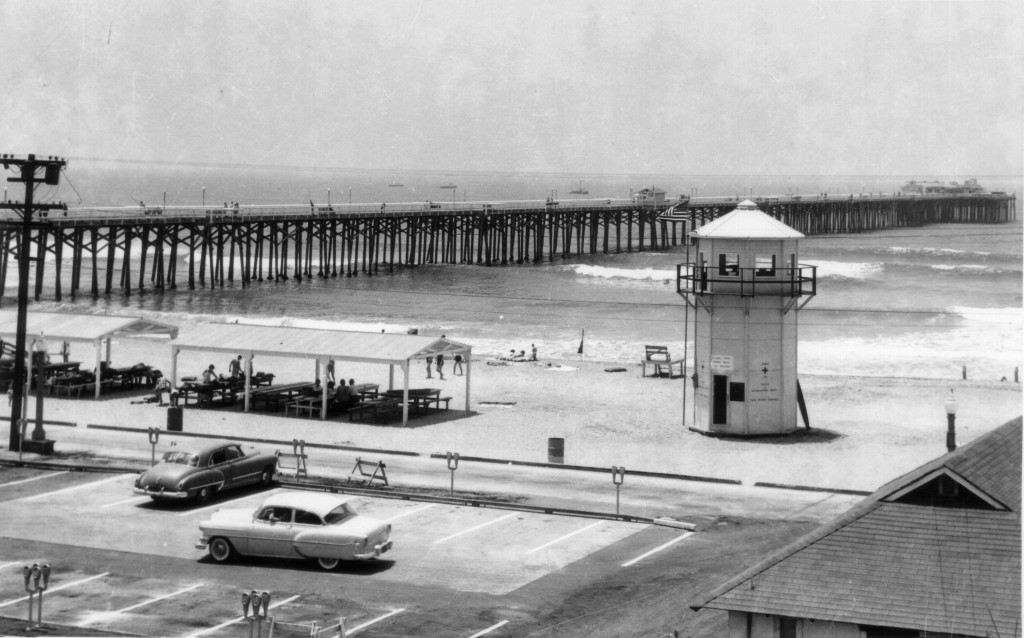For nearly 70 years the story of a sunken ship laden with gold off the coast of Oceanside has persisted and the details, told by a master storyteller, have become urban legend.
Dr. Joseph James Markey, who told these stories with great and ever changing detail, was once described as “the real life model to Steven Spielberg’s ‘Indiana Jones’ of ‘Raiders of the Lost Ark’.”

For two decades Dr. Markey and his wife Helen lived a rather quiet life in Oceanside. They lived in a modest home on Hoover Street in the Loma Alta neighborhood before moving to a palatial one on South Pacific Street near the exclusive St. Malo enclave. Markey had a small office on South Hill Street.

One June 13, 1947 Joseph Markey traveled to Paris. The Oceanside newspaper reported that his plane had engine trouble but that he had landed safely. Markey was on “a month’s business trip to Paris and other cities.” He returned about five weeks later and his comments about his trip were published, stating that communism “in France and other European countries is gaining ground in many ways” in large part due to organized strikes.
The following year, Markey was under a bit of scrutiny for supporting and advising embattled councilmember Russell A. Allhouse who was facing a recall for disparaging and slanderous statements he made about other councilmembers and in his own publication entitled “Veterans’ Advocate”, alleging that he “printed false, misleading, and scurrilous statements tending to pit class against class, individual against individual, and to create distrust, dissention, and a lack of unity.”
It is telling that Markey would support such a divisive person and one who printed “false and misleading statements.”

It must have come as quite a surprise for Oceanside residents on February 3, 1950 when they unfolded their daily paper to read the front page headline in large block letters: “Old Documents Record Ten Million Dollars in Gold Lies in San Luis Rey Valley.”
In an article written by Dr. J. J. Markey himself (rather than a reporter), he claimed to have traveled to Spain in 1947, presumably on his Paris trip, and discovered that “ten million dollars in gold [was] buried on a hillside in the San Luis Rey Valley.” Markey said that he had discovered documents “reposing in the Archivo General de Indias in Seville, Spain.” These long-lost papers were simply “gathering dust” waiting for Markey to bring them to light.
The story Markey wrote involved one Francisco de Ulloa, “a trusted lieutenant” of Spanish conquistador Hernán Cortés. It was Ulloa that buried “this hoard of gold” and it was somewhere in the hills of the San Luis Rey Valley. Markey had a map which was provided to him by a descendant of Ulloa, drawn in “meticulous detail.” He told the story of this mysterious map and the stranger who brought it to him like a narrative from a cheesy pulp fiction novel:
“First,” he said, “I show you the map.” His English was not bad. A caressing accent. “You have regarded many maps in your eventful life,” he went on, understandingly. “And most of them–all of them–were frivolous. But this one, Monsieur,” and he was genuinely serious. “Is what you call the McCoy.”
One could question, if a man was in the possession of this map which pinpointed supposed locations of gold caches, why didn’t this person come and claim the gold for himself?!
Here are the “facts” that Markey presented in the local newspapers that would be repeated in hundreds of newspapers across the country…sometime more embellished by the discoverer as he saw fit:
- Francisco de Ulloa died on the banks of what we now call the San Luis Rey River.
- Before dying he directed his “loot from Mexico” to be buried in 3 caches.
- Maps with meticulous detail would determine the location of any of the three was found.
- A member of his party, one Pablo Salvador Hernandez, returned to Mexico in 1541 and provided details of Ulloa’s fate and the buried gold in a diary.
In spite of the long-established story of Juan Rodriguez Cabrillo discovering California, Markey insisted he alone had found the true explorer: It was Francisco de Ulloa who discovered and then traveled past the San Diego Bay on the Trinidad, a 35-ton caravel. On June 30, 1540, he reached the mouth of the San Luis Rey River where for “two days the ship lay at anchor while the vessel’s casks were filled with fresh water.” According to Markey, Ulloa and his men offloaded $10 million worth of gold which would be buried and hidden for 400 years.

As incredible as Markey’s story was, soon regional and then national newspapers picked up the story which gained considerable interest including the San Diego Union and the Los Angeles Times. Nearly every week Markey fed the newspaper another story, or detail about Ulloa and his treasure. On February 13, 1950 the Blade Tribune published another story, again written by Markey with the opening paragraphs:
“History abounds with dramatic narratives of explorers setting out to discover new trade routes, northwest passages or shorter water-ways. And, as in the case of Columbus and countless others, history records that more often than not the adventurer discovered something better than his original objective.
“That’s the way it was with Francisco de Ulloa, the first white man to visit Oceanside and our nearby San Luis Rey valley. When Ulloa started out from Mexico in 1539 he was looking for a city as large as Mexico City. A city so extravagantly wealthy that its buildings were made of silver. One of the seven cities of Cibola. But as I said, he discovered Oceanside instead. And stayed here.“
Although Paul Beck, publisher of the Oceanside Blade Tribune, printed Markey’s stories on his front page, (because they sold newspapers) he did write in an editorial stating that “John Davidson, San Diego Historical Society director, has taken issue with Dr. Markey. He says the treasure is not in San Luis Rey valley … or anywhere near it.”
Davidson further refuted Markey’s claims, saying that “According to all known historical data, Ulloa was sent out in 1540 to resupply the expedition of Coronado. He never got north of the Gulf of Mexico. It was not until two years later that Cabrillo sailed up the West Coast, the first navigator in history to make the trip. If he named the rivers and landmarks, we don’t know. His log has never been discovered.“

Not to be outdone, Markey wrote another account the following day with more details, which again read like a novel:
“Late in the year 1539, Francisco de Ulloa, the first white man to set foot on the territory now occupied by the city of Oceanside, set sail from Cedros Island, a bare rock protuberance in the Pacific, off the coast of Mexico. He headed the prow northward. The wind was favorable at that time of the year. He was able to keep his 35-ton vessel within sight of land most of the time.
“He mapped the coast with commendable accuracy, noting Point Loma and the two islands off Mexico, within sight of San Diego. He rounded the point on which La Jolla now reposes and moved into the concavity formed by the land at Encinitas.
“At the mouth of the San Luis Rey river his lookout perceived the first movement on shore since he had left Mexico. The purposeful movements of the figures on the beach forced him to conclude they were human.
“He ordered his ship to stand off. Oarsmen eagerly volunteered to man a boat. Long before they approached the surf they could make out the fresh water river that cut through the sand and flattened the surf out to a degree that afforded an easy passage through the combers rolling in from the open sea.
“Ulloa, himself, accompanied this first boat. The brown Indians gathered in cautious knots on the beach. Not retreating. Nor yet moving forward inquisitively.
“‘The men were naked,’ the diarist of the landing party wrote, ‘and the women wore short aprons or skirts of woven grass. These extended from the waist to the knees. Some few had skins and furs incorporated in the weaving.’“
Markey’s incredible claims were not done because just days later he “discovered” what he called the “San Luis Rey Man,” a skull of a man found less than a mile from the Mission San Luis Rey. It was reported (by Markey) that “anthropologists” estimated the skull to be from 10,000 to 20,000 years old. In newspaper articles printing his claims, Markey is described as physician, author and scientist, and in which he declared: “Excavation of this skull may prove this valley the greatest hunting grounds in the world for prehistoric-man fossils of Pliocene and Pleistocene periods.“
As proof of his assertions, Markey wrote that an unnamed “anthropologist” visited his home on South Pacific Street and it was during this visit that Markey took the alleged opportunity for the skull to be examined. The melodramatic conversation Markey published is below:
“At the dinner table, at the conclusion of his first meal, I presented him with a human skull and jawbone for an expert appraisal.
“‘Probably an Indian,’ I told him. And I’m hoping he’s about 400 years dead. That would place him in the valley just where we wanted him, at the same time as Francisco de Ulloa who, I understand, buried a lot of gold down there in 1540.’
“My guest pushed back his chair a little and inspected the relics without enthusiasm. It was a long head. ‘Dolichocephalic,’ he pronounced. ‘A chinless, prognathous jaw like a chimpanzee. Big canine teeth.’ Only there were no teeth. They had rotted away before the man died. ‘Not much of a supraorbital ridge,’ he went on reciting. ‘A male. About 30 years old. Yet, an old man. Probably died of old age and deficiency diseases at 30.’
“I was fascinated not only by his recital, but by the fact that he took his pipe out of his mouth and used it as a pointer, shoving it into eye sockets and nasal passages, and rattling it on the bone for emphasis, then putting it back in his mouth.
“‘This boy had a small brain,’ he went on. ‘Smaller than the aboriginal Australian’s.’ As he spoke, he grew more thoughtful. And finally stopped his narrative to examine detail of the ancient bone with close attention.
“After a long moment he regarded me alertly. ‘It’s just possible you’ve got more here than you bargained for,’ he said. ‘Let’s go out and look at the place you found it.’“
Markey came to the conclusion that “a cautious scientist giving his first estimate could say with safety than San Luis Rey Man is more than 10,000 years old.”
Years later, in 1958, Markey left for Europe with “fossils of San Luis Rey Man” to be “examined by experts.” But nothing was ever mentioned again of San Luis Rey Man.
Detailed stories continued to pour in weekly, sometimes daily from Markey. While he claimed ownership of what he described as a detailed map, the gold could not be found. But that did not stop Markey from continuing his stories as his notoriety grew across the country. Markey said he was in possession of the diary written by Pablo Hernandez, (seen only by Markey).
Questions arose such as to why the men removed the gold from the ship? According to Markey, Hernandez wrote that the men took the gold with them because they were “inveterate gamblers.” Who were they going to gamble with? The Native people?
Markey had a disdainful attitude towards the indigenous people living in what would be called the San Luis Rey Valley, describing them as “simple and backward” in several writings. His derogatory verbiage published in numerous articles, stated that they displayed “retarded aboriginal customs and animal-like daily life” and that “they possessed no system of writing or communication beyond the simple noises that constituted their language and existed on a borderline between human and animal.” In fact, he wrote: “Some described [them] as being more like animals than human.”
When questioned about his “findings”, Markey simply referred to the Hernandez diary. It was Hernandez who noted the “extraordinary mental and physical laziness” of the people.” It was Hernandez, who allegedly wrote that the Natives “were like wholly wild animals.“
To truly understand the depths of his loathing towards the Native people of our area, Markey wrote a further number of offensive narratives published in magazine and newspaper articles:
- Male and females sit for hours at a time wholly occupied with removing vermin from the hairy areas of their bodies. Having recovered the vermin with his fingers, the native proceeded to pop it into his mouth and eat it.
- “They were like wholly wild animals that had not yet learned to fear white men and their implements of death.”
- In an article written for “True, the Man’s Magazine”, (July, 1965) Markey describes the Luiseños supposed super-charged “sex drive” and purports that both sexes routinely engaged in pedophilia.
What became of Ulloa and his men? According to Markey, the men who left their ship began to die of dysentery due to the filthy living conditions of the Indians.
“The Spaniards were repelled by the smell of the villages. Each rude hut was festooned with ripe and drying fish and animal meat. The sanitary facilities were like those of a wretchedly kept pig-pen. The lake shore was at once the cesspool, the bathtub and the drinking fountain of the village.”
M. R. Harrington, curator of the Southwest Museum, wrote Markey to correct him on his public view and disdain of the Indians. Harrington’s retort doesn’t age well either, but did refute Markey’s statements.
In his letter Harrington wrote: “The Luiseños were a simple people, but hardly filthy, their very religion demanded that everybody bathe every morning if water was available. And that is more than can be said of Europeans of that period. As to sanitation, when nature called, they went out into the bushes, same as everybody else, except Europeans in cities of the period, who usually threw their night soil out into the street.
“You can be sure that Luiseños did not go to their drinking water or bathing pools for this purpose. Garbage was thrown on dumps for dogs to eat. The disease which killed so many of the Ulloa party was probably not caught from Indians, but was scurvy, the same that caused the death of so many crew men in 1769 when San Diego Mission was established. I have visited many Indian tribes, lived with them, and the “wildest” were often the cleanest.”
Markey’s story continued with Pablo Hernandez finding Ulloa close to death who said to him, “Too many people are dying have all the men put their gold together and bury it. Take it two leagues away where no natives will see you. Mark the location well. When the illness has passed, those who live on can recover it.”
In early 1952 Markey was referred to as an “Oceanside Paleontologist” and was announced as the principal speaker at San Diego Historical Society. It was stated that would “outline the results of his 20 years of excavation and research in the San Luis Rey Valley.” It is a curious statement but certainly Markey was no stranger to exaggeration or fabrication.
In July 1952 he announced that he was going to seek the whereabouts of the fossil remains of the Peking Woman. Described as a “local archeologist” it was said that “Dr. Markey, who will represent a national archeological organization on his round-the-world trip, intends also to do some further research into records of early San Luis Rey Valley Indians.” His travels would take him to “Manila, Hong Kong, Calcutta, Singapore and the Island of Java. His Pan-American itinerary lists Honolulu, Tokyo, Hong Kong, Manila, Batavia (Java), Singapore, Rangoon, Calcutta, Bombay, Basra, Beirut, Istanbul, Athens, Rome, Paris and Madrid.“
He arrived back to the states in late September, with no mention of the Peking Woman, but he still made headlines by stating that “he thinks women are inferior to men” and after all, he should know because “he does research on the potential of the female mind.” He went on to insult women everywhere by saying that the “accomplishment potential of women is staggeringly low” adding that they “shouldn’t even be allowed to vote, because women can’t think in sociological areas beyond the narrow horizons of their own small lives.“
Markey never apologized for these remarks and would even repeat them in other publications.

While he didn’t return with the lost fossils of the PekingWoman, Markey did say that on his trip abroad he found drawings made by men from the ill-fated Ulloa party. These depictions were of the Luisenos made by “the scribe of the Ulloa party” that indicated “these early Indians were different in appearance from those of our present day tribes. They were distinctly lowbrow; with receding foreheads; high, heavy eye-brow rides; broad, flat noses with depressed nasal roots; long narrow faces and heads and lips in muzzles that protruded like a gorilla.”
In addition to the supposed 10,000 year-old “San Luis Rey Man”, in 1953 Markey announced that he would examine what he called the skull of the “Wilson Man” (so named because it was found by Howard Wilson of Laguna Beach.) Apparently Markey had the credentials to do so, although he was neither a paleontologist nor an archaeologist.

Markey asserted that the Wilson Man “was a contemporary of Neanderthal Man in Europe” and that he dated the skull “to just before and in the earlier part of the last great glaciations, which occurred 100,000 — 50,000 years ago.”
Never publically announced, but kept in Markey’s records, was a note from George Stromer, of Laguna Beach who acquired the remains from Howard Wilson, and in turn delivered them to Markey that read:
“Received from J. J. Markey the fragments of skull and skeleton which I delivered to him in the year 1953, and which were called the Wilson fragments in the newspaper in that year. At that time I informed him that I had gotten them from Mr. Wilson of Laguna Beach. The skeletal fragments have been appraised as being that of a white man about 35 – 40 who died about 1860. Dr. Markey and I have agreed this day that all the fragments that I delivered to him in 1953 have been returned to me today, October 27, 1961.”

Markey’s accounts continued about Ulloa and the lost gold, which remained buried somewhere in the rolling hills of the San Luis Rey Valley. He established the San Luis Rey Historical Society, of which he was the President and was an invited guest speaker for many organizations eager to hear more about buried treasure worth $10 million.
And that was the story that Markey told for seven years. Until 1957 when he suddenly switched gears and announced that Ulloa’s ship, The Trinidad, had drifted unmanned and sunk off the coast somewhere between Solana Beach and Del Mar… along with the gold. Markey reported that skin divers were now looking for the remains of the ship and the treasure that went down with it.

Why this sudden change of story? Was the gold buried in the Valley or not? What about this “meticulous” map? Now the gold was supposedly buried along with Trinidad. Markey gave no explanation, but kept spinning his yarns.
In order to locate the area where the ship sank, Markey claimed to have rafts “weighted to the estimated tonnage of the Trinidad and set adrift in the Pacific Ocean off Oceanside” which then “drifted down the coast and sunk south of Del Mar. That’s about where the Trinidad ought to be,” said Markey.
How did Pablo Hernandez return (and have his diary discovered) if the Trinidad sunk?
If the Trinidad weighed 35 tons, how and when did Markey conduct his experiments? Who assembled these rafts? How were 35 tons of anything placed on them? Who watched them float and then sink? AND what made them sink?
If they did in fact sink south of Del Mar, why would these rafts sink in the same location where the Trinidad allegedly sunk? (Markey later referred to the rafts as barges but they are likely just as mythical as the rest of his “research.”)
Simultaneously sharing the story of the now sunken Trinidad, Markey claimed to have discovered the grave of Francisco de Ulloa, and in a separate area, a mass grave of his men. Reports varied, but Markey would claim 20 to 22 skeletons were found.

Photos depicted Markey and others standing by a cave entrance, along with a cement headstone, and signage claiming it to be the gravesite of Ulloa. Markey said it was determined to be Ulloa’s remains because “buttons and metal decorations from a Spanish uniform of the 16th century indicating a man of Ulloa’s rank” along with fragments of Spanish armor, helmets, knives and other weapons” were found. Later, he changed the story that Ulloa had been buried in “full regalia.”
Soon after the “discovery” a white picket fence was added to Ulloa’s gravesite. No credible archeologist or anthropologist would erect a headstone, let alone a picket fence, around a real archaeological site. Nearby stones which were supposedly decorated with ancient petro glyphs were “enhanced” by Markey with white paint. No one thought to ask Markey how “animal-like people” could create such an image carved in stone.

As supposed deep sea divers were searching for the Trinidad off the coast, Markey offered a $10,000 reward to anyone who could find the gold on the bottom of the sea floor, and then, quickly retracted the offer the following day.
Crews of men, along with state-of-the-art equipment were unable to locate the ship but the idea was intriguing to many treasure seekers.
In 1969 Bill Takasato of Long Beach, who headed the crew of The Gleaner, said that he believed he had found the spot near where the Trinidad had sunk. The crew located what they felt was the hulk of the Trinidad 3,300 feet off the 1200 block of South Pacific, under 31 feet of water and 8 feet of sand.
Despite what should have been exciting news, Markey disputed their findings. “It isn’t where we think it is … We feel it is a bit further down. Hernandez, the scribe, drew a map which depicts an area much like the terrain near the power plant off Carlsbad.”
A map where the Trinidad sank? Then why couldn’t the ship be found?
Two months later the search by Takasato was called off due to lack of funding and Markey was curiously quiet. He knew it wasn’t the Trinidad because the Trinidad never sank. It seems Markey was satisfied with storytelling and the notoriety that with it but had no real interest in finding the ship or the gold because he knew it didn’t exist.
Finally, in 1971 Stephen T. Garrahy and David J. Weber openly challenged Markey’s claims in the California Historical Society Quarterly. Weber was an associate professor at San Diego State College; Garrahy a graduate student in Latin American history at the University of Texas at Austin.

Along with the numerous historical “facts” disputed by the two, was a photo of Markey taken in a cave. In the photo are several skulls and bones and Markey, bare-chested, is holding a skull. In 1955 this photo was published claiming that Markey was in Tahiti, holding what he said was a skull of a cannibal. Garrahy and Weber pointed out that the same photo was used in 1957, only reversed or flipped, showing Markey in a cave where Ulloa’s crew were purportedly discovered in the San Luis Rey Valley.
In response, Markey granted an interview to Genevieve Claussen of the San Diego Magazine where he expounded upon his many illustrious exploits and discoveries and actually downplayed the story of Ulloa, rather than boasting of it as he done for two decades. When challenged on his claims, Markey’s continual response was to dispute and discount all other historians no matter their degree or expertise.
“I don’t know why we should take up our time with every Tom, Dick and Harry who wishes to waste our time. I have used the word ‘scientist, or historians of stature’. We are always glad to talk to them.”
“Who is a person of stature?” Markey rhetorically queried and answered: “If he has 50 lines or more in Who’s Who in America.“
The self-important Dr. Markey was neither a scientist nor a historian. His criteria of importance were not “their degree or expertise” but only that they be included in a vanity publication in which he provided his own questionable and disputable accomplishments.
In 1981 James R. Moriarty, a professor at the University of San Diego, also refuted Markey’s stories stating that Francisco de Ulloa had in fact returned to Mexico and then Spain, where he later died and was buried. Divers never located the Trinidad, he said, because it didn’t sink, and grave sites, if they existed, would be those of local Indians.
Dr. Markey died in 1985 with the neither the Trinidad nor the gold ever discovered. Some believe it is still in the Pacific.
But what became of the skulls and bones that Markey claimed were Ulloa’s and his crew? Where are the graves? Where is the map? Where is the diary? What became of the San Luis Rey Man? Why did Markey unashamedly perpetuate such wild stories as truth? What compelled him?
There’s more to uncover and discover about James J. Markey…until next time. Stay tuned.





